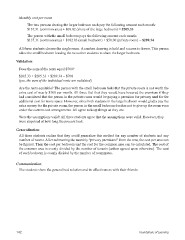Page 148 - Foundations of Learning, 4th Edition (Revised)
P. 148
Monthly cost per room
The two persons sharing the larger bedroom each pay the following amount each month:
$137.31 (common area) + $68.02 (share of the large bedroom) = $205.33
The person with the small bedroom pays the following amount each month:
$137.31 (common area) + $102.03 (small bedroom) + $50.00 (private room) = $289.34
All three students choose the single room. A random drawing is held and a name is drawn. This person
takes the small bedroom leaving the two other students to share the larger bedroom.
Validation:
Does the sum of the rents equal $700?
$205.33 + $205.33 + $289.34 = $700
(yes, the sum of the individual rents are validated)
Are the rents equitable? The person with the small bedroom feels that the private room is not worth the
extra cost of nearly $100 per month. All three feel that they would have lowered the premium if they
had considered that the person in the private room would be paying a premium for privacy and for the
additional cost for more space. However, since both students in the large bedroom would gladly pay the
extra money for the private room, the person in the small bedroom decides not to give up the room even
under the current cost arrangements. All agree to keep things as they are.
Were the assumptions valid? All three students agree that the assumptions were valid. However, they
were surprised at how long the process took.
Generalization:
All three students realize that they could generalize this method for any number of students and any
number of rooms. After subtracting the monthly “privacy premiums” from the rent, the cost per area can
be figured. Then the cost per bedroom and the cost for the common area can be calculated. The cost of
the common area is evenly divided by the number of tenants (unless agreed upon otherwise). The cost
of each bedroom is evenly divided by the number of roommates.
Communication:
The students share the generalized solution and its effectiveness with their friends.
142 Foundations of Learning

